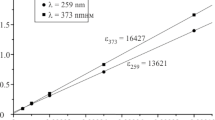Abstract
New types of potent aprotinin-containing medicinal polymer films are elaborated for topical applications. The higher the temperature of drying, the lower the steam absorption, the film swelling, and the velocity of aprotinin in vitro release. The presence of antimicrobials having the basic functional groups contributed to compacting the structure of the films and retention of aprotinin in them. The velocity of aprotinin release from the films is regulated by adding different polymers. Inclusion of polyvinylpirrolidone in the film resulted in acceleration and increase of aprotinin release. This was probably because of increasing the film swelling by a factor of 1.7. Additional retention of the inhibitor in films was achieved by inclusion of sodium alginate and cellulose powder capable of binding aprotinin. Soluble bioadhesive films derived from a copolymer of acrylamide,N-vinyl-pirrolidone, ethyl acrylate (M r 30,000-600,000) and aprotinin were obtained and analyzed. Kinetics of aprotinin release from biosoluble films was studied under various conditions. The duration of aprotinin release was comparable with duration of gradual dissolution of the matrix. Bioavailability of aprotinin from soluble films was linear with time.
Similar content being viewed by others
References
Fritz, H. and Wunderer, G. (1983),Arzneim.-Forsch./Drug Res. 33, 479–494.
Haberland, G. L. and Lewis, D. H. (1973),Neue Aspekte der Trasylol-Therapie. Bd. G, Schattauer Verlag, Stuttgart.
Larionova, N. I., Sakharov, I. Yu., Kazanskaya, N. F., Zhuravlyov, A. G., Vladimirov, V. G., and Tolstich, P. I. (1980), inFuture Directions: Enzyme Engineering, Plenum, New York, pp. 241–255.
Larionova, N. I., Balabushevitch, N. G., Gladysheva, I. P., Moroz, N. A., Kazanskaya, N. F., Polekhina, O. V., and Donetsky, I. A. (1994),Vopr. Med. Khim. 40, 25–31 (in Russian).
Larionova, N. I., Kazanskaya, N. F., and Torchilin, V. P. (1984), inBiotechnology (in Russian), Bayev, A. A., ed., Nauka, Moscow, pp. 113–125.
Chase, T. and Shaw, E. (1967),Biochem. Biophys. Res. Commun. 29, 508–514.
Schwert, G. W. and Takenaka, Y. A. (1955),Biochim. Biophys. Acta 16, 570–576.
Timokhina, V. I., Lapo, V. G., and Lanina, S. Ya. (1982), inMedical-Technical Problems of Human Individual Defence, vol. 23, Katscheyev, V. S., ed., Institute of Biophysics Press, Moscow, pp. 97–102.
Doubois, M., Gilles, K. A., Hamilton, J. K., Roberts, P. A., and Smith, F. (1956),Anal. Chem. 28, 350–356.
Khromov, G. L. (1992),Med. Prog. Through Technol 18, 9–13.
Mishina, S., Gasset, A., and Klyce, S. (1966),Invest. Ophthalmol. and Vis. Sci. 5, 264–276.
Author information
Authors and Affiliations
Rights and permissions
About this article
Cite this article
Balabushevitch, N.G., Kildeyeva, N.R., Moroz, N.A. et al. Regulating aspects of biosoluble and insoluble film release systems containing protein proteinase inhibitor. Appl Biochem Biotechnol 61, 129–138 (1996). https://doi.org/10.1007/BF02785695
Issue Date:
DOI: https://doi.org/10.1007/BF02785695




